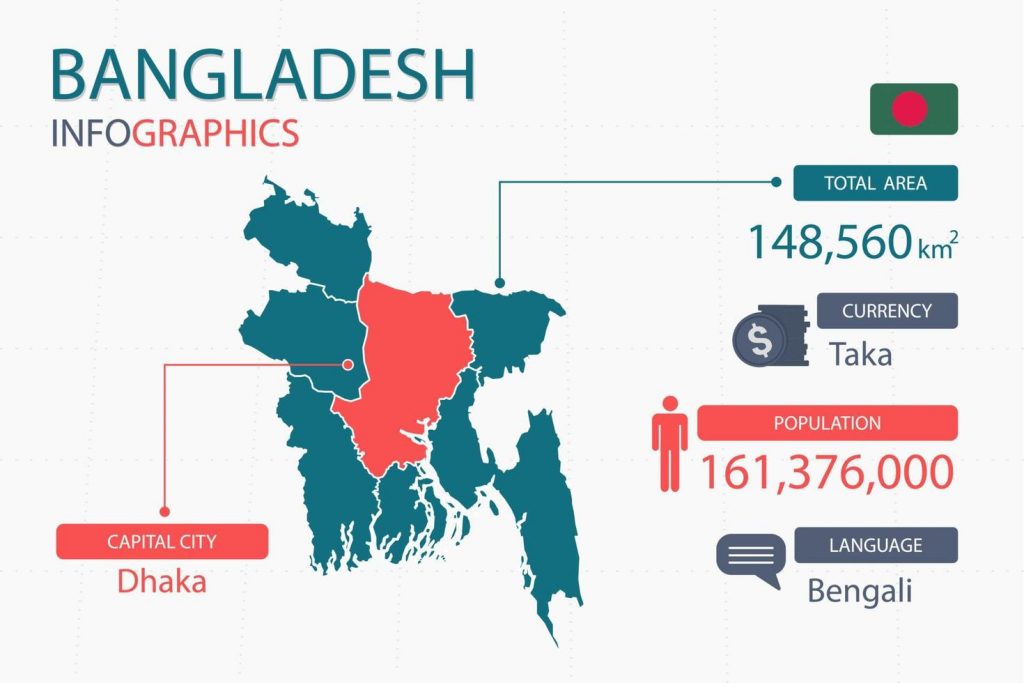The origins of the Bengali Language
Bengali is a language that is spoken mostly on the Indian Subcontinent. It is the official language of the People’s Republic of Bangladesh. Moreover, it is one of the scheduled languages of India, meaning that it holds official status. In India, it is the official language of the following states: West Benga, Tripura, Assam and the Andaman and Nicobar Islands. Throughout these territories and regions, Bengali has about 238 million speakers with most of the speakers living in Bangladesh.
Bengali is written using the Bengali alphabet. This alphabet is an abugida, which is a script with letters for consonants with an inherent vowel, and smaller marks or signals that signify vowel changes. The script is cursive, with letters being joined together, and there are no upper- and lower-case versions. One reads Bengali from left to right, and there are spaces between words. In addition, there is a horizontal line running along the top of the letters that join them together, called a matra. Our Bengali Translators can translate English to Bengali for Bangladesh or India. Bengali is also referred to as ‘Bangla’ by its geographical area, Bangladesh.
Grammatical features that differ in Bengali compared to more well-known Western European languages include its word order, case, and its use of measure words. In general, Bengali grammar follows a subject-object-verb order, even though there are variations. In addition, Bengali uses postpositions as opposed to prepositions that are found in English and other European languages. Nouns and pronouns are altered depending on their case, which is the grammatical role they play in the sentence. Measure words are also used for nouns, which is similar to Chinese, Japanese, and other East Asian languages.

In its linguistic history, Bengali stems from Sanskrit, which was the language spoken during the Gupta empire. Sanskrit was the major religious language of Hinduism at this time and was considered a holy language. Other dialects, collectively called Magadhi Prakrit, were also spoken in this region. Bengali is believed to have evolved from both Sanskrit and these group of dialects. At this time, Bengali as we know it today did not exist as one identifiable unit, but various varieties and dialects existed that would soon be known as Bengali. However, even at this early time, various authors wrote in these different dialects and these would form the foundation of Bengali literature.
During medieval times, the period can be considered the Middle Bengali period where Bengali continued to develop into its current form today. Throughout this time period, the influence of the Arabic and Persian languages were absorbed into the Bengali language. In addition, Bengali became an official language of the court for the Sultanate of Bengal. The Muslim rulers of the region promoted the development of Bengali, especially in terms of literature and its use in administration and this played a role in its linguistic development.
The period of modern Bengali can be said to have started around 19th and 20th century where its literature continued to be developed. Bengali, as it now exists, it quite different in terms of its spoken forms and literary forms. This gap is unique among the world’s modern languages. With its long literary tradition, historical occurrences, and overall linguistic evolution, the vocabulary and grammar of modern Bengali can be said to have a number of influences. Current Bengali has vocabulary that can trace its roots back to Sanskrit, Pali, Persian, and Arabic. In addition, due to centuries of contact with Europeans and Turkic people, words that originate from the languages that these people spoke have also been integrated into the core vocabulary of modern Bengali. These include words from Portuguese, French, and Dutch. In addition, during the colonial period of the Indian Subcontinent, the English language has also heavily influenced modern Bengali.
In modern times, the Bengali language is both the national and official language of Bangladesh. In addition, it is one of the 23 official languages of India. It is also a recognized language of the City of Karachi in Pakistan. Both the national anthems of Bangladesh and India were written in Bengali. With Bengali spoken in many regions, many regional variations and dialects have emerged. In comparison to other languages, Bengali is considered to have a rich and long history of literature and has had a major influence in the region it has existed in.
Modern Bengali is also very known for its language movements, especially in the Indian Subcontinent. As an example, the Bengali Language Movement was a movement that emerged to protect Bengali’s recognition as a state language in the Dominion of Pakistan, when legislation tried to make Pakistani the only official language of the country. During protests tied to this movement, five protesters were killed, including students. In 1956, Bengali became a state language of Pakistan. Many who speak Bengali are proud of the fact that there have been people who died for the language.
There has also been movements taking place in the Indian state of Assam in 1961, and a proposition in 2010 to make Bengali an official UN language. Thus, the Bengali language can be considered an important element of culture and identity for the people who speak it and is a bond for people in an otherwise very culturally and geographically diverse region.
VEQTA can provide you with a perfect Bengali translator for your Bengali translation, English to Bengali translation and Bengali to english translation for the your targeted locale. Our translations to Bengali are created with your target audience in mind to meet your expectations.
If you need to translate Bengali – Get in touch today!
A dedicated team of Bengali translators who combines Experience, Specialized Subject Matter Expertise with best Translation Practices to deliver quality second to none.
Bengali Subject Expertise
Bengali Translators
Bengali Editors
Bengali Copywriters
Bengali Reviewers
Bengali Voice dubbing
Bengali Subtitling
Bengali Transcription


